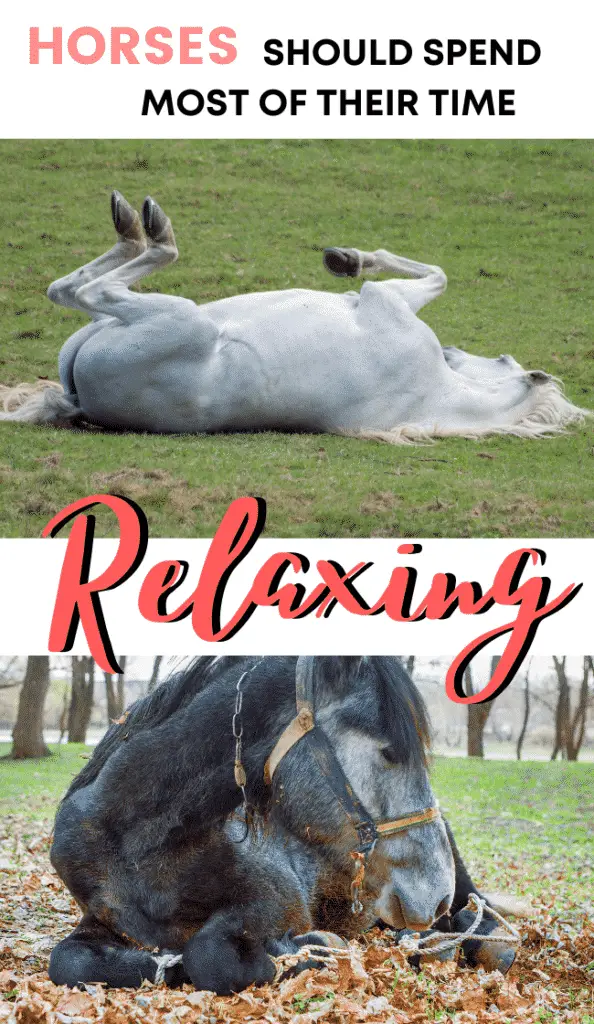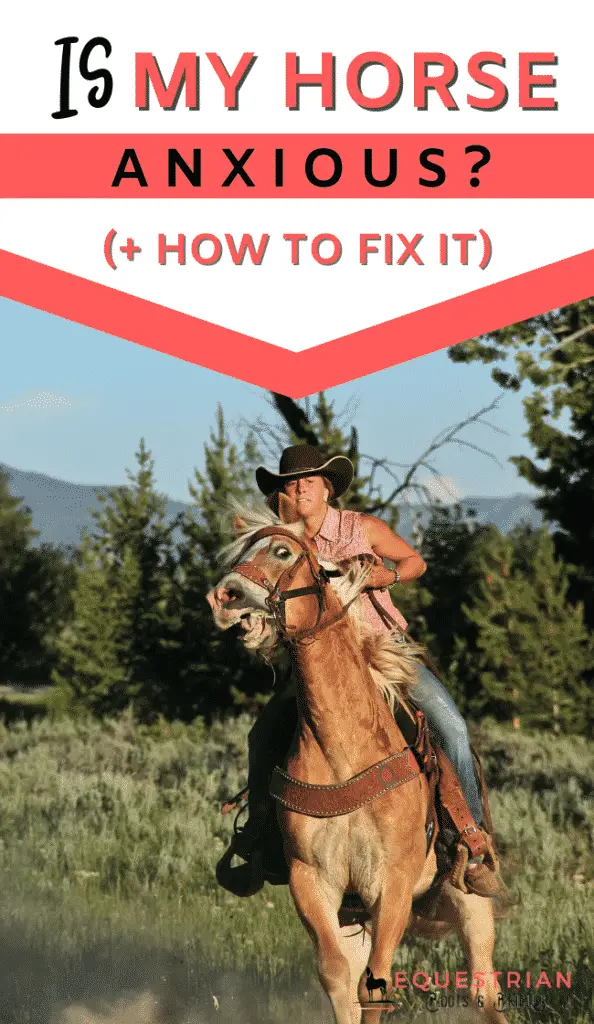Just like humans, horses can build up anxiety. Horses are built to live in a state of “rest-and-digest” where they’re parasympathetic nervous system is more activated than they’re sympathetic nervous system. If these sound like foreign words to you, don’t worry – they did to me too!
Essentially, the sympathetic nervous system gets activated to tell your body: DANGER, RUN OR FIGHT!
This is the state we are in when we feel anxious about something. Our mouth goes dry, our hearts beat faster, we get all this nervous energy that we don’t know what to do with, we start sweating, etc.
The parasympathetic nervous system gets activated to tell your body: socialize, relax, eat, sleep, rest and digest.
In order to calm down your horse when they get anxious, you’ve got to intervene physically or mentally.
You can physically get them to relax when riding through relaxation exercises. You can also mentally get them to relax by recognizing the signs of anxiety and then communicating to your horse that they’re actually safe so they can relax.
I’ll walk through the process of how I do both below.
Horses (And Humans!) Should Spend Most of Their Time Eating, Sleeping and Relaxing
Nature intended the parasympathetic state to be the state that humans, horses and all other mammals live in. The idea was that when there is danger, the sympathetic nervous system kicks in for a while and then when the danger’s gone, the parasympathetic can take over again.

As humans, we get inundaded with so many stressors all day every day that anxiety (aka always being in that sympathetic state) has become a big problem for us.
Domestic horses can also run into the same issue. Horses didn’t evolve to live with humans. If the communication system between horse and human isn’t working well so that the horse knows he’s safe and he can relax, he can go into that constant state of always being anxious and having a ton of nervous energy.
How Do I Know If My Horse is Anxious?
A telltale sign that your horse might have this issue is if they’re spooking at everything and very reactive. Usually these horses won’t give you any relaxed indicators either (licking and chewing, hanging they’re head low, yawning, rolling or lying down).

I rode a bay Arabian gelding named Dash and this was 100% his problem. He was actually the horse that got me started really thinking about this and looking for solutions because I just couldn’t get a handle on him.
Note that a lot of horses that have this high reactivity and high anxiety will also have physical weaknesses.
Just like when we feel anxious, it’s a mixture of physical and mental affects, it’s the same with horses. Horses that are anxious have a more difficult time bending and stretching in ways that would make them stronger because they’re more tense and stiff a lot of the time.
It’s a vicious cycle really because the stiffness prevents them from getting stronger and their lack of strength makes them weaker.
2 Ways to Calm Anxiety: Circle to Stop & Learn To Communicate With Your Horse
These are some of the coolest things I’ve learned about horses! I first starting learning about them from Warwick Schiller, a horse trainer down in California.
What you’re doing with these techniques is you are effectively teaching your horse to meditate. You’re teaching them to slow down they’re thinking, stop racing off to worst case scenarios about everything around them and just to be present and calm in the moment.
Pretty neat, eh?
Method 1 – How Do I Get My Horse to Relax When Riding?
The first way works really well when you’re riding. The exercise is pretty simple – it’s basically circling to stop.
The idea is that anytime your horse is going too fast and you can feel they’re out of control, you would use this technique to bring them down to a halt without actually halting them. While they’re circling, they physically can’t hold onto all that stress and anxiety for very long because it just becomes too difficult while they’re bent.
You’ll feel them soften and eventually when the circle gets small enough, they’ll stop and once they stop, you’ll release the bend. It’s remarkable how much that does to bring a horse emotionally from 100 to 0 in very little time.
What’s important is not to only use this when you really need it.
Think of panic attacks in humans (similar to a horse spooking at something and then bolting away from it). A mindfulness technique is not likely to work if the person only tries to use it when they’re having a panic attack. You have to practice it every single day. Preferably when you’re pretty calm and then if you get the tiniest bit upset about something, you would use some breathing exercices to calm you down.
Then you would progress to implementing them when you’re a little bit more upset and so on. Eventually, you would get so good at calming yourself down that you would be able to use the techniques in the middle of a panic attack successfully.
The same goes with your horse.
You want to practice this a lot so that when you really need it, it works. I would say try circling to a stop first from a walk in both directions, then at a trot and then finally at a controlled canter.
Once your horse is really good at all of those, then you can be pretty confident the trick will work for you when your horse is way too forwards or has just spooked from something. This is an excellent solution for slowing down a bolting horse, for instance.
When you’re practicing, a trick to do this well is to put your weight in your outside stirrup, leave your outside rein loose and just take and soften with your inside rein slowly shortening it until the circle is as small as you can make it. Once your at that point then just hold until your horse walks himself to a stop.
ONLY release that inside rein once your horse has come to a stop. You’re teaching him that he’ll get the release once he’s settled down and quiet. How to calm a horse while riding can be extremely useful if your horse is fresher or fizzy that day, if he’s just spooked, if you feel like he’s about to spook or to settle him down into “working mode” after a fast trail ride or gallop.
Method 2 – How to Calm A Stressed Horse Through Communication
The second technique of learning how to communicate with your horse properly is a little bit out of the scope of this post. I’ll go through a short version here but I’ve actually put together an entire 5 week course called “Ground-Up Horsemanship” that goes through the ins and outs of learning to “speak horse” for lack of a better term.
What you want to learn to recognize is your horses signals. Horses are actually communicating with you ALL THE TIME. The way their ears move, the flick of their tails, the movement of their feet, their weight distribution, the angle of their necks, the way their muzzles are moving, and MUCH MORE.
If you learn how to read these signals, understand what they mean AND you learn to communicate back to your horse that you actually saw them and know what they mean, you can completely and utterly transform the relationship you have with your horse.
A 4-step crash course in this is as follows:
- Recognize stress indicators: lifting head higher, flicking tail, pawing the ground, stepping away, stepping forwards, not standing still, turning the head away from you without pricking the ears in that direction.
- Indicate to your horse that you saw his indicator: stop what you were trying to do at the moment where the indicator appeared (i.e. let’s say you were trying to get the saddle on) OR take one step away if you weren’t doing anything at that moment.
- Wait for a relaxation indicator: blinking, head dropping lower, licking and chewing, sighing, yawning, rolling.
Continue doing what you were trying to do before and go back to step 1.
I’ve had people where I ride already question my choice to do this. The traditional thinking is that you do whatever you need to do (i.e. tack up, brush, lead, get on, ride, get off, etc.) and the horse is supposed to be obedient that whole time. If they’re not obedient than you keep doing whatever it is you’re doing until they fall in line. But think from the horse’s perspective how stressful that might be? It might feel to the horse as if they’ve got no control whatsoever over they’re lives.
All I know is that when I started these with Rudy (my 4 year old gelding), they literally changed him. When I first got him, he would spook at EVERY LITTLE THING. Literally, any noise would make him bolt in the opposite direction. Furthermore, he was super pushy and was on top of me and nipping all the time.
Looking back now, I realize he was just living in a higher state of stress than he needed to all the time! It’s interesting too how that change of perspective from “my horse is pushy and disobedient and bad” to “my horse is just really stressed out” will change your whole outlook and experience with your horse.
If you’re interested in learning more about my thinking on communicating with horses, you can check out my course: Ground-Up Horsemanship.
I talk more about slowing down hot horses in my FREE Beginner Rider’s EBook. It’s 8 Chapters of the biggest lessons I’ve learnt while riding that I wish I knew as a beginner with 2 more advanced Chapters and 4 Bonus Chapters on cantering and jumping!
Sign up below and you’ll get it directly to your inbox for free:
Want to learn more about rushing horses? This is my entire library of posts just on slowing down horses:
- 3 Reasons Your Horse Is Rushing & How to Fix It
- How to Slow A Horse Down Without Pulling The Reins
- Stop Rushing In The Canter
- How to Slow Down A Horse
Having other issues with your horse? Here’s some other posts I’ve written you might like:
- How to Move A Horse Forward Under Saddle
- The Secret Walk-to-Trot Riding Aid
- How to Sit the Trot
- How to Establish Neck Flexion
- How to Collect a Horse
- How to Ride Without Stirrups
- How to Stop a Bolting Horse
- How to Ask for the Canter
- How to Master Jumping While Minimizing Fall Risk
Happy riding,
Martina
Like this post? Share it!




Just stumbled across your website! Great information! I am now working with my first horse (I’m almost 60)! My daughter had a horse, but this is mine! She is 18 and great, although she likes to gait, not walk! I’ve been working on walking and your suggestions line up with what I am trying to do! thank you so much!